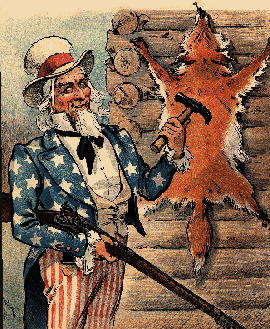
Uncle Sam first appeared during the War of 1812 between the United States and Great Britain. He emerged as a folksy, backswood opponent of "John Bull," the traditional symbol of British power. Before the 1860s, Uncle Sam was clean-shaven; his image after the Civil War borrowed Abraham Lincoln's beard, lanky physique, and stovepipe hat. By the Gilded Age he was a familiar figure, used by cartoonists particularly to represent the United States in its foreign relations, but also to symbolize patriotism and national authority. He typically appeared--as today--in the stars and stripes of the U.S. flag.
The images here are from Puck, one of the few 1890s magazines with color cartoons. In both, Uncle Sam wears his typical trousers and hat. At right is from 30 October 1889; below, from 28 November 1900, Puck celebrates William McKinley's second electoral victory over William Jennings Bryan.


15 April, Sound Money
25 April, Ram's Horn
28 June, L.A. Times
6 August, Sound Money
9 September, Rocky Mountain News
11 September, St. Louis Globe Democrat
13 September, L.A. Times
17 September, Rocky Mountain News
18 September, St. Louis Post-Dispatch
26 September, Harper's Weekly<BR> 26 September, National Reflector
29 September, L.A. Times
15 October, Sound Money
December, Overland Monthly
